Teaching Methods in Early Childhood Education Report - ECTPP301A
VerifiedAdded on 2023/06/03
|18
|4267
|361
Report
AI Summary
This report delves into the realm of early childhood education, presenting a comprehensive analysis of the author's teaching philosophy and the practical application of various teaching techniques. The author emphasizes creating a supportive, inclusive, and flexible learning environment, aligning with the EYL framework and incorporating a play-based curriculum. The report explores both generalist techniques, such as singing, listening, and modeling, and specialist techniques, including documenting, task analysis, and problem-solving. Each technique is defined, explained in the context of early childhood education, and linked to underlying theoretical perspectives. The report critically evaluates the relevance and effectiveness of these techniques, considering developmental considerations for different age groups and the Australian Curriculum. Furthermore, the report underscores the importance of Children's Rights Education, the ECA Code of Ethics, and the Australian Professional Teaching Standards in shaping the author's teaching practice. The report concludes by highlighting the interconnectedness of these elements in fostering a positive and effective learning environment for young children.
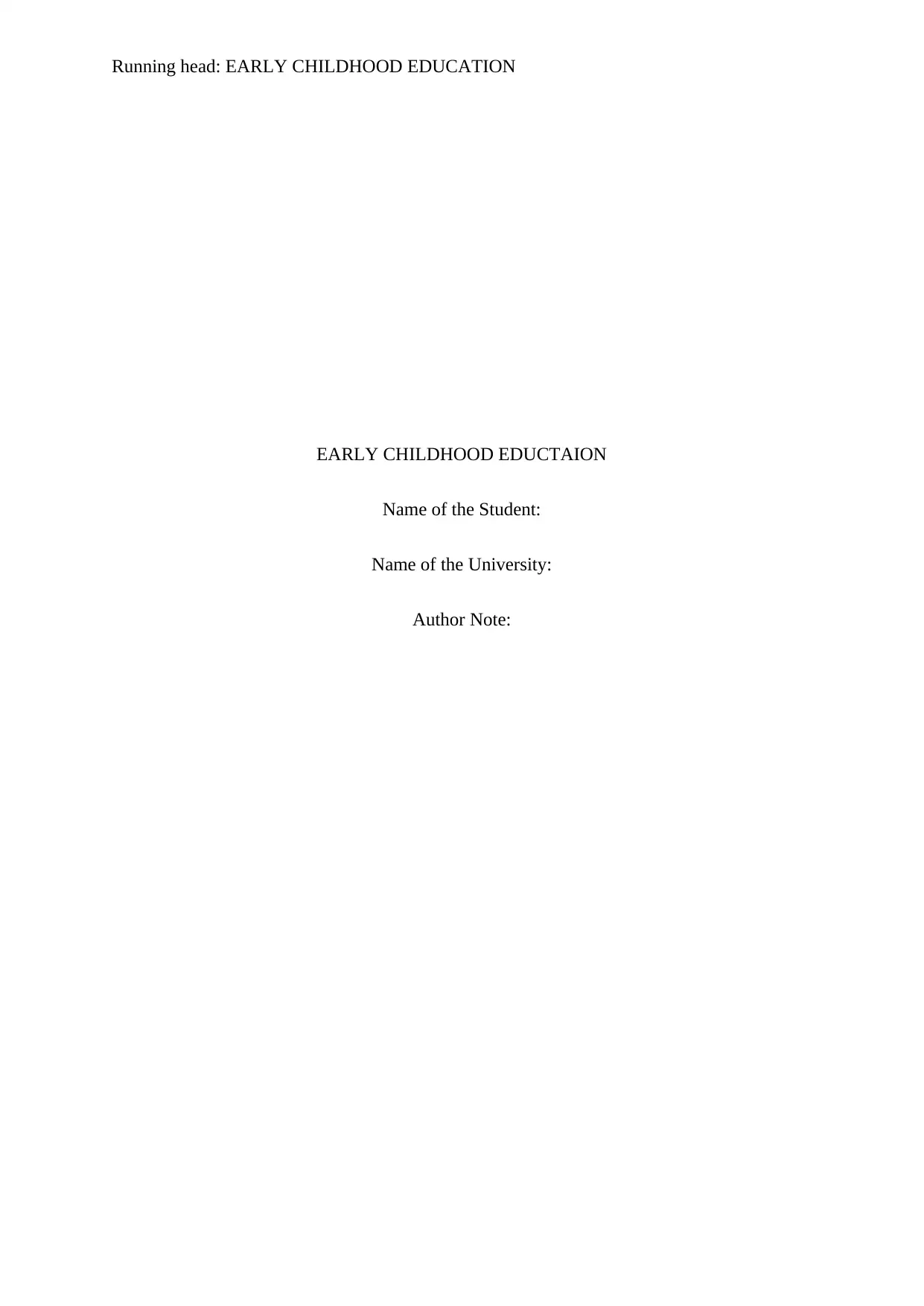
Running head: EARLY CHILDHOOD EDUCATION
EARLY CHILDHOOD EDUCTAION
Name of the Student:
Name of the University:
Author Note:
EARLY CHILDHOOD EDUCTAION
Name of the Student:
Name of the University:
Author Note:
Paraphrase This Document
Need a fresh take? Get an instant paraphrase of this document with our AI Paraphraser
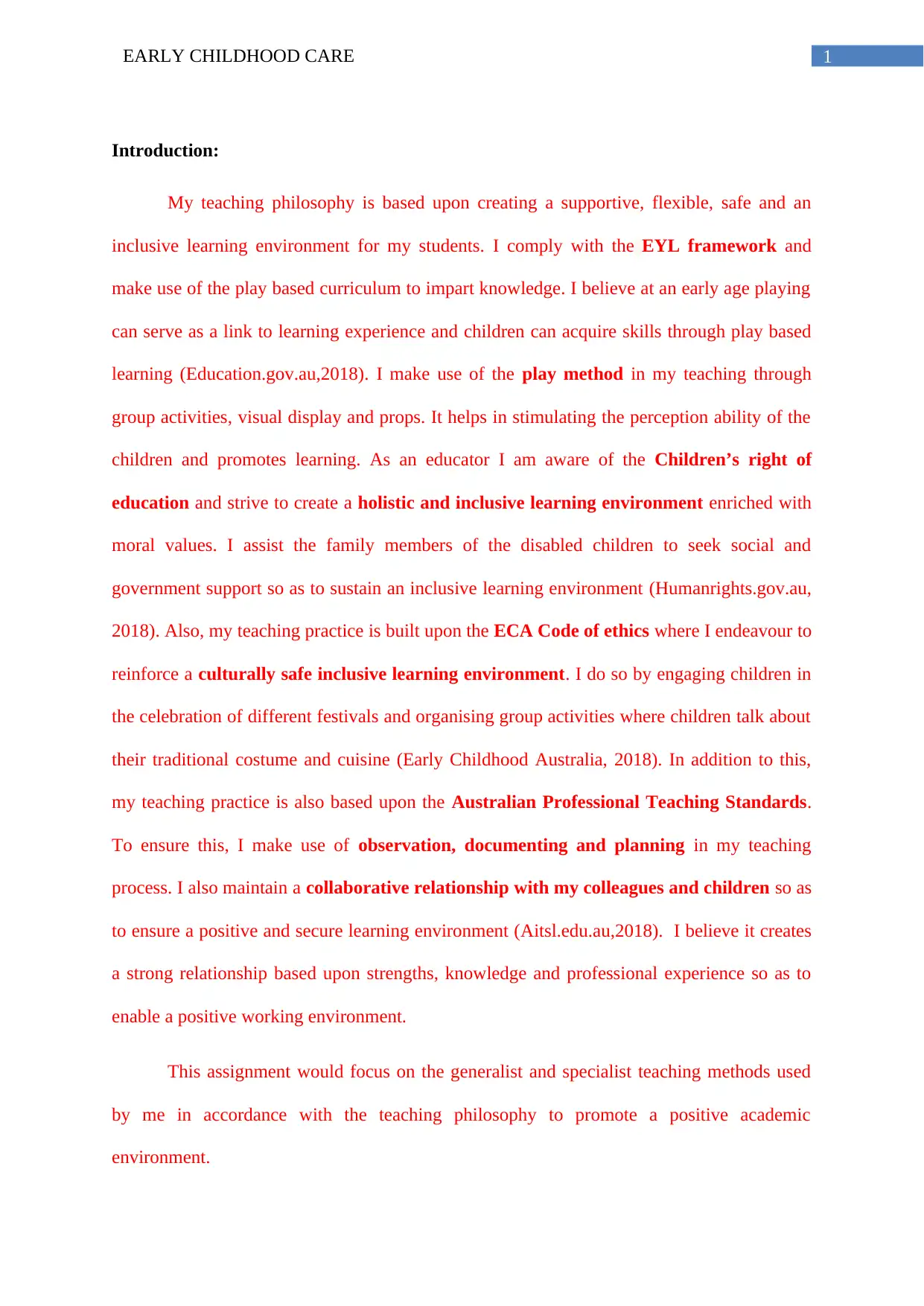
1EARLY CHILDHOOD CARE
Introduction:
My teaching philosophy is based upon creating a supportive, flexible, safe and an
inclusive learning environment for my students. I comply with the EYL framework and
make use of the play based curriculum to impart knowledge. I believe at an early age playing
can serve as a link to learning experience and children can acquire skills through play based
learning (Education.gov.au,2018). I make use of the play method in my teaching through
group activities, visual display and props. It helps in stimulating the perception ability of the
children and promotes learning. As an educator I am aware of the Children’s right of
education and strive to create a holistic and inclusive learning environment enriched with
moral values. I assist the family members of the disabled children to seek social and
government support so as to sustain an inclusive learning environment (Humanrights.gov.au,
2018). Also, my teaching practice is built upon the ECA Code of ethics where I endeavour to
reinforce a culturally safe inclusive learning environment. I do so by engaging children in
the celebration of different festivals and organising group activities where children talk about
their traditional costume and cuisine (Early Childhood Australia, 2018). In addition to this,
my teaching practice is also based upon the Australian Professional Teaching Standards.
To ensure this, I make use of observation, documenting and planning in my teaching
process. I also maintain a collaborative relationship with my colleagues and children so as
to ensure a positive and secure learning environment (Aitsl.edu.au,2018). I believe it creates
a strong relationship based upon strengths, knowledge and professional experience so as to
enable a positive working environment.
This assignment would focus on the generalist and specialist teaching methods used
by me in accordance with the teaching philosophy to promote a positive academic
environment.
Introduction:
My teaching philosophy is based upon creating a supportive, flexible, safe and an
inclusive learning environment for my students. I comply with the EYL framework and
make use of the play based curriculum to impart knowledge. I believe at an early age playing
can serve as a link to learning experience and children can acquire skills through play based
learning (Education.gov.au,2018). I make use of the play method in my teaching through
group activities, visual display and props. It helps in stimulating the perception ability of the
children and promotes learning. As an educator I am aware of the Children’s right of
education and strive to create a holistic and inclusive learning environment enriched with
moral values. I assist the family members of the disabled children to seek social and
government support so as to sustain an inclusive learning environment (Humanrights.gov.au,
2018). Also, my teaching practice is built upon the ECA Code of ethics where I endeavour to
reinforce a culturally safe inclusive learning environment. I do so by engaging children in
the celebration of different festivals and organising group activities where children talk about
their traditional costume and cuisine (Early Childhood Australia, 2018). In addition to this,
my teaching practice is also based upon the Australian Professional Teaching Standards.
To ensure this, I make use of observation, documenting and planning in my teaching
process. I also maintain a collaborative relationship with my colleagues and children so as
to ensure a positive and secure learning environment (Aitsl.edu.au,2018). I believe it creates
a strong relationship based upon strengths, knowledge and professional experience so as to
enable a positive working environment.
This assignment would focus on the generalist and specialist teaching methods used
by me in accordance with the teaching philosophy to promote a positive academic
environment.
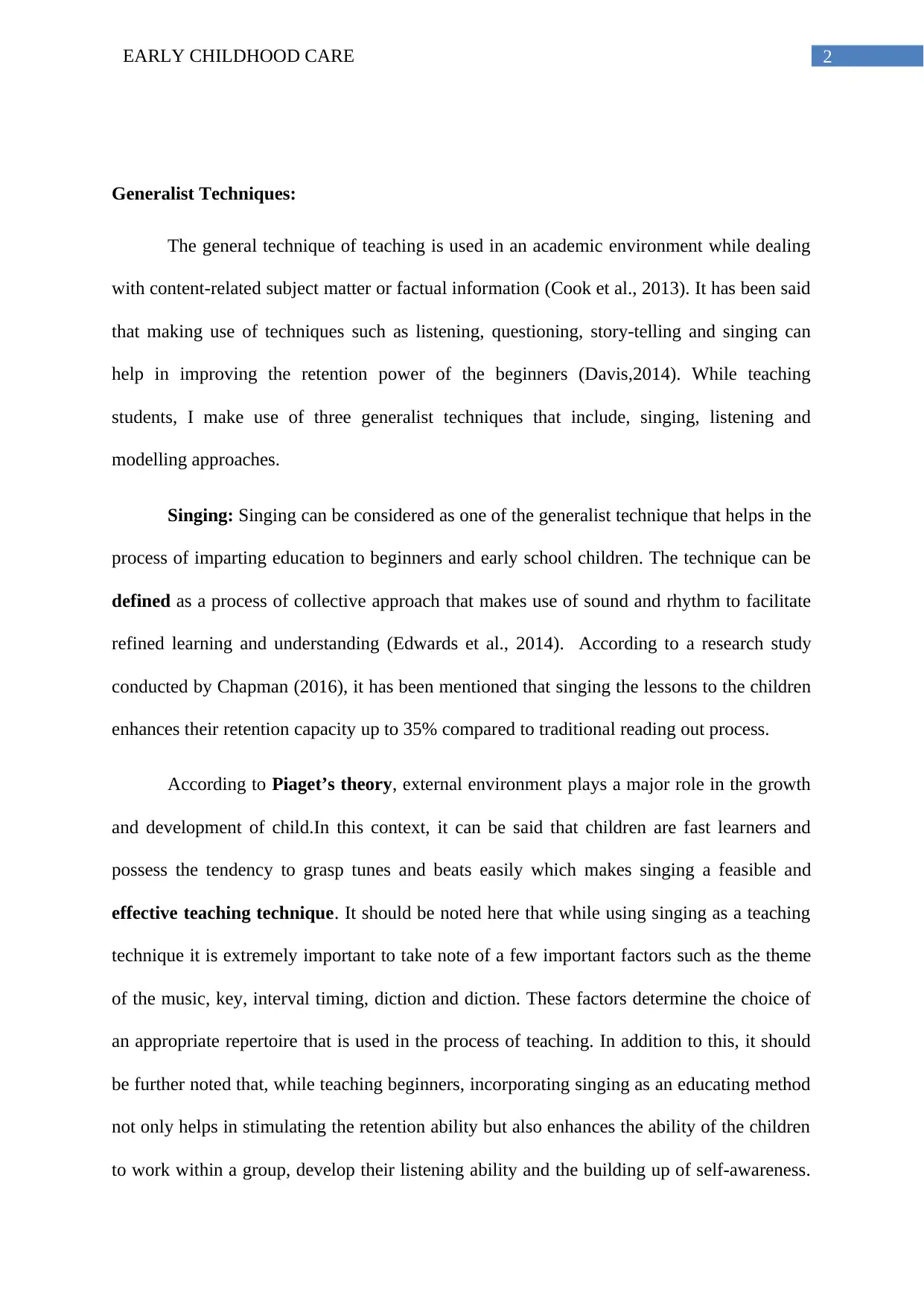
2EARLY CHILDHOOD CARE
Generalist Techniques:
The general technique of teaching is used in an academic environment while dealing
with content-related subject matter or factual information (Cook et al., 2013). It has been said
that making use of techniques such as listening, questioning, story-telling and singing can
help in improving the retention power of the beginners (Davis,2014). While teaching
students, I make use of three generalist techniques that include, singing, listening and
modelling approaches.
Singing: Singing can be considered as one of the generalist technique that helps in the
process of imparting education to beginners and early school children. The technique can be
defined as a process of collective approach that makes use of sound and rhythm to facilitate
refined learning and understanding (Edwards et al., 2014). According to a research study
conducted by Chapman (2016), it has been mentioned that singing the lessons to the children
enhances their retention capacity up to 35% compared to traditional reading out process.
According to Piaget’s theory, external environment plays a major role in the growth
and development of child.In this context, it can be said that children are fast learners and
possess the tendency to grasp tunes and beats easily which makes singing a feasible and
effective teaching technique. It should be noted here that while using singing as a teaching
technique it is extremely important to take note of a few important factors such as the theme
of the music, key, interval timing, diction and diction. These factors determine the choice of
an appropriate repertoire that is used in the process of teaching. In addition to this, it should
be further noted that, while teaching beginners, incorporating singing as an educating method
not only helps in stimulating the retention ability but also enhances the ability of the children
to work within a group, develop their listening ability and the building up of self-awareness.
Generalist Techniques:
The general technique of teaching is used in an academic environment while dealing
with content-related subject matter or factual information (Cook et al., 2013). It has been said
that making use of techniques such as listening, questioning, story-telling and singing can
help in improving the retention power of the beginners (Davis,2014). While teaching
students, I make use of three generalist techniques that include, singing, listening and
modelling approaches.
Singing: Singing can be considered as one of the generalist technique that helps in the
process of imparting education to beginners and early school children. The technique can be
defined as a process of collective approach that makes use of sound and rhythm to facilitate
refined learning and understanding (Edwards et al., 2014). According to a research study
conducted by Chapman (2016), it has been mentioned that singing the lessons to the children
enhances their retention capacity up to 35% compared to traditional reading out process.
According to Piaget’s theory, external environment plays a major role in the growth
and development of child.In this context, it can be said that children are fast learners and
possess the tendency to grasp tunes and beats easily which makes singing a feasible and
effective teaching technique. It should be noted here that while using singing as a teaching
technique it is extremely important to take note of a few important factors such as the theme
of the music, key, interval timing, diction and diction. These factors determine the choice of
an appropriate repertoire that is used in the process of teaching. In addition to this, it should
be further noted that, while teaching beginners, incorporating singing as an educating method
not only helps in stimulating the retention ability but also enhances the ability of the children
to work within a group, develop their listening ability and the building up of self-awareness.
⊘ This is a preview!⊘
Do you want full access?
Subscribe today to unlock all pages.

Trusted by 1+ million students worldwide
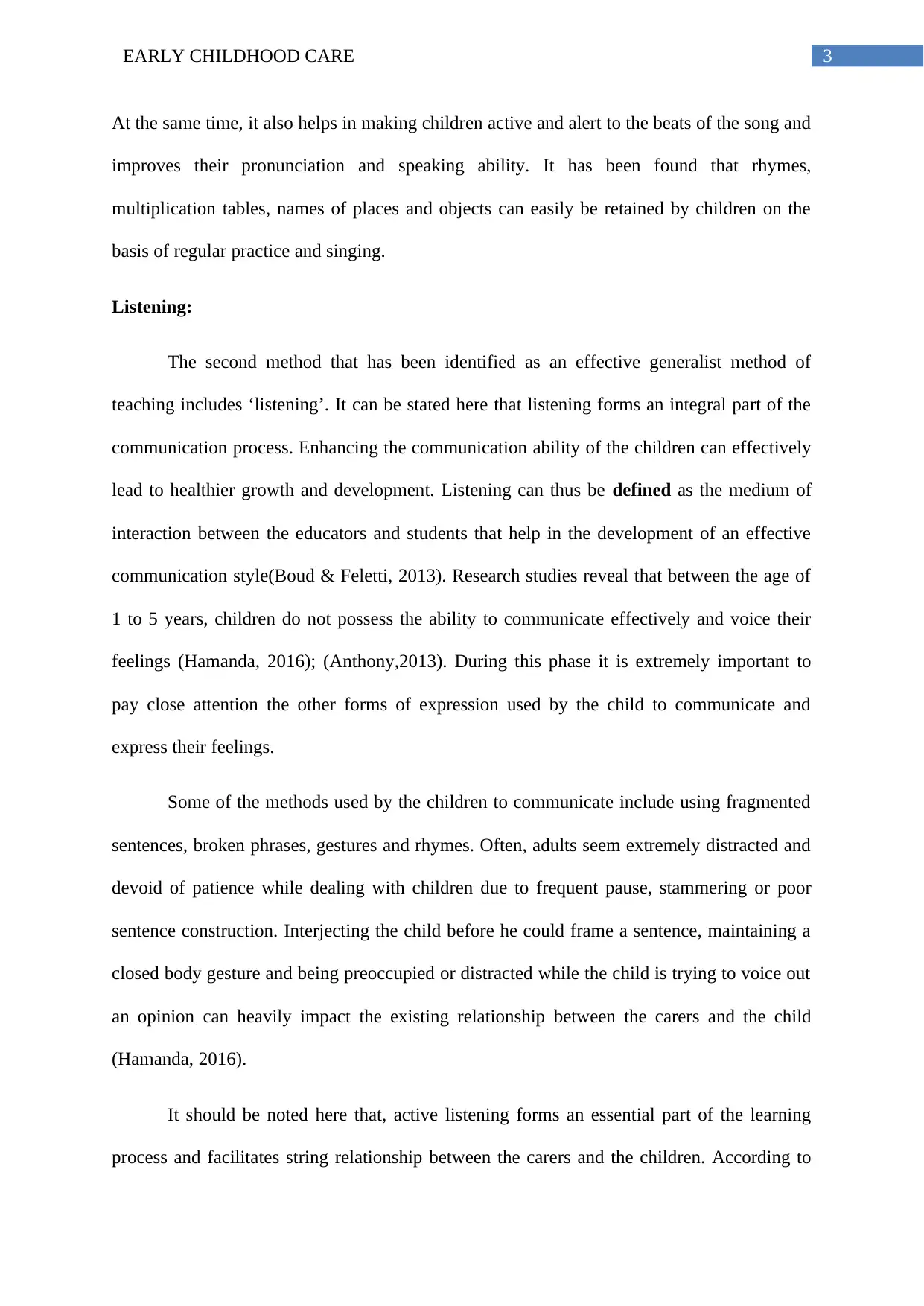
3EARLY CHILDHOOD CARE
At the same time, it also helps in making children active and alert to the beats of the song and
improves their pronunciation and speaking ability. It has been found that rhymes,
multiplication tables, names of places and objects can easily be retained by children on the
basis of regular practice and singing.
Listening:
The second method that has been identified as an effective generalist method of
teaching includes ‘listening’. It can be stated here that listening forms an integral part of the
communication process. Enhancing the communication ability of the children can effectively
lead to healthier growth and development. Listening can thus be defined as the medium of
interaction between the educators and students that help in the development of an effective
communication style(Boud & Feletti, 2013). Research studies reveal that between the age of
1 to 5 years, children do not possess the ability to communicate effectively and voice their
feelings (Hamanda, 2016); (Anthony,2013). During this phase it is extremely important to
pay close attention the other forms of expression used by the child to communicate and
express their feelings.
Some of the methods used by the children to communicate include using fragmented
sentences, broken phrases, gestures and rhymes. Often, adults seem extremely distracted and
devoid of patience while dealing with children due to frequent pause, stammering or poor
sentence construction. Interjecting the child before he could frame a sentence, maintaining a
closed body gesture and being preoccupied or distracted while the child is trying to voice out
an opinion can heavily impact the existing relationship between the carers and the child
(Hamanda, 2016).
It should be noted here that, active listening forms an essential part of the learning
process and facilitates string relationship between the carers and the children. According to
At the same time, it also helps in making children active and alert to the beats of the song and
improves their pronunciation and speaking ability. It has been found that rhymes,
multiplication tables, names of places and objects can easily be retained by children on the
basis of regular practice and singing.
Listening:
The second method that has been identified as an effective generalist method of
teaching includes ‘listening’. It can be stated here that listening forms an integral part of the
communication process. Enhancing the communication ability of the children can effectively
lead to healthier growth and development. Listening can thus be defined as the medium of
interaction between the educators and students that help in the development of an effective
communication style(Boud & Feletti, 2013). Research studies reveal that between the age of
1 to 5 years, children do not possess the ability to communicate effectively and voice their
feelings (Hamanda, 2016); (Anthony,2013). During this phase it is extremely important to
pay close attention the other forms of expression used by the child to communicate and
express their feelings.
Some of the methods used by the children to communicate include using fragmented
sentences, broken phrases, gestures and rhymes. Often, adults seem extremely distracted and
devoid of patience while dealing with children due to frequent pause, stammering or poor
sentence construction. Interjecting the child before he could frame a sentence, maintaining a
closed body gesture and being preoccupied or distracted while the child is trying to voice out
an opinion can heavily impact the existing relationship between the carers and the child
(Hamanda, 2016).
It should be noted here that, active listening forms an essential part of the learning
process and facilitates string relationship between the carers and the children. According to
Paraphrase This Document
Need a fresh take? Get an instant paraphrase of this document with our AI Paraphraser
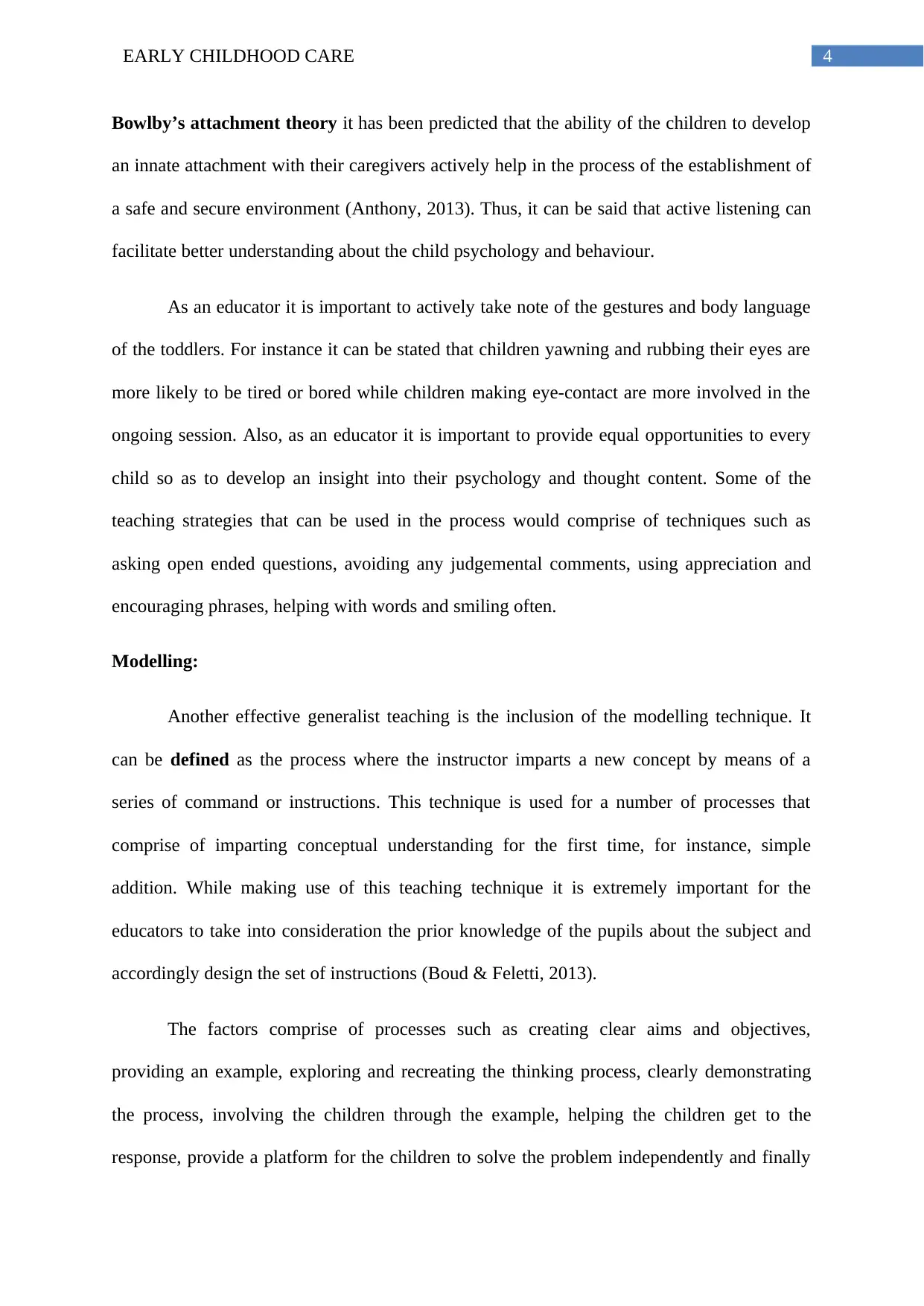
4EARLY CHILDHOOD CARE
Bowlby’s attachment theory it has been predicted that the ability of the children to develop
an innate attachment with their caregivers actively help in the process of the establishment of
a safe and secure environment (Anthony, 2013). Thus, it can be said that active listening can
facilitate better understanding about the child psychology and behaviour.
As an educator it is important to actively take note of the gestures and body language
of the toddlers. For instance it can be stated that children yawning and rubbing their eyes are
more likely to be tired or bored while children making eye-contact are more involved in the
ongoing session. Also, as an educator it is important to provide equal opportunities to every
child so as to develop an insight into their psychology and thought content. Some of the
teaching strategies that can be used in the process would comprise of techniques such as
asking open ended questions, avoiding any judgemental comments, using appreciation and
encouraging phrases, helping with words and smiling often.
Modelling:
Another effective generalist teaching is the inclusion of the modelling technique. It
can be defined as the process where the instructor imparts a new concept by means of a
series of command or instructions. This technique is used for a number of processes that
comprise of imparting conceptual understanding for the first time, for instance, simple
addition. While making use of this teaching technique it is extremely important for the
educators to take into consideration the prior knowledge of the pupils about the subject and
accordingly design the set of instructions (Boud & Feletti, 2013).
The factors comprise of processes such as creating clear aims and objectives,
providing an example, exploring and recreating the thinking process, clearly demonstrating
the process, involving the children through the example, helping the children get to the
response, provide a platform for the children to solve the problem independently and finally
Bowlby’s attachment theory it has been predicted that the ability of the children to develop
an innate attachment with their caregivers actively help in the process of the establishment of
a safe and secure environment (Anthony, 2013). Thus, it can be said that active listening can
facilitate better understanding about the child psychology and behaviour.
As an educator it is important to actively take note of the gestures and body language
of the toddlers. For instance it can be stated that children yawning and rubbing their eyes are
more likely to be tired or bored while children making eye-contact are more involved in the
ongoing session. Also, as an educator it is important to provide equal opportunities to every
child so as to develop an insight into their psychology and thought content. Some of the
teaching strategies that can be used in the process would comprise of techniques such as
asking open ended questions, avoiding any judgemental comments, using appreciation and
encouraging phrases, helping with words and smiling often.
Modelling:
Another effective generalist teaching is the inclusion of the modelling technique. It
can be defined as the process where the instructor imparts a new concept by means of a
series of command or instructions. This technique is used for a number of processes that
comprise of imparting conceptual understanding for the first time, for instance, simple
addition. While making use of this teaching technique it is extremely important for the
educators to take into consideration the prior knowledge of the pupils about the subject and
accordingly design the set of instructions (Boud & Feletti, 2013).
The factors comprise of processes such as creating clear aims and objectives,
providing an example, exploring and recreating the thinking process, clearly demonstrating
the process, involving the children through the example, helping the children get to the
response, provide a platform for the children to solve the problem independently and finally
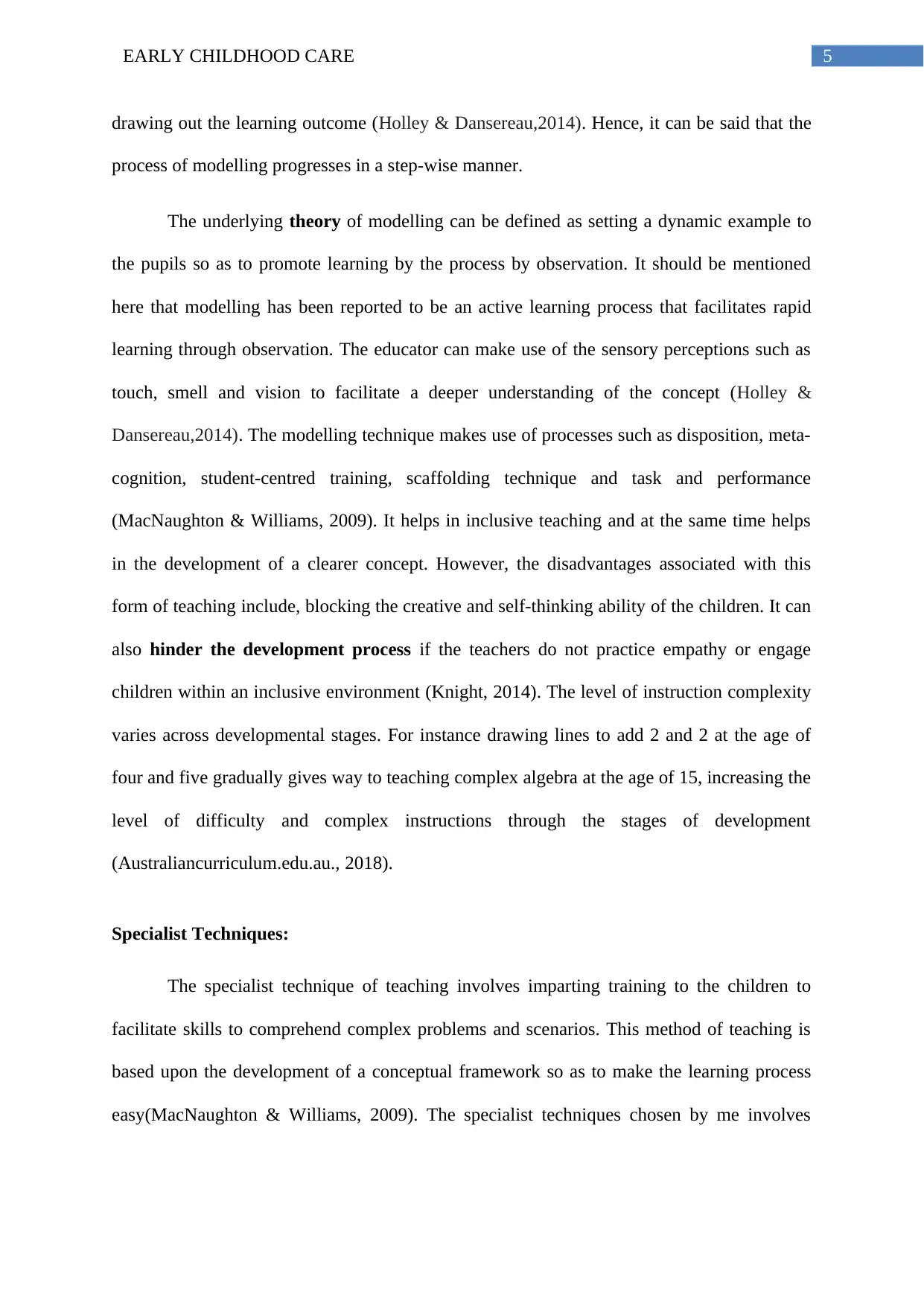
5EARLY CHILDHOOD CARE
drawing out the learning outcome (Holley & Dansereau,2014). Hence, it can be said that the
process of modelling progresses in a step-wise manner.
The underlying theory of modelling can be defined as setting a dynamic example to
the pupils so as to promote learning by the process by observation. It should be mentioned
here that modelling has been reported to be an active learning process that facilitates rapid
learning through observation. The educator can make use of the sensory perceptions such as
touch, smell and vision to facilitate a deeper understanding of the concept (Holley &
Dansereau,2014). The modelling technique makes use of processes such as disposition, meta-
cognition, student-centred training, scaffolding technique and task and performance
(MacNaughton & Williams, 2009). It helps in inclusive teaching and at the same time helps
in the development of a clearer concept. However, the disadvantages associated with this
form of teaching include, blocking the creative and self-thinking ability of the children. It can
also hinder the development process if the teachers do not practice empathy or engage
children within an inclusive environment (Knight, 2014). The level of instruction complexity
varies across developmental stages. For instance drawing lines to add 2 and 2 at the age of
four and five gradually gives way to teaching complex algebra at the age of 15, increasing the
level of difficulty and complex instructions through the stages of development
(Australiancurriculum.edu.au., 2018).
Specialist Techniques:
The specialist technique of teaching involves imparting training to the children to
facilitate skills to comprehend complex problems and scenarios. This method of teaching is
based upon the development of a conceptual framework so as to make the learning process
easy(MacNaughton & Williams, 2009). The specialist techniques chosen by me involves
drawing out the learning outcome (Holley & Dansereau,2014). Hence, it can be said that the
process of modelling progresses in a step-wise manner.
The underlying theory of modelling can be defined as setting a dynamic example to
the pupils so as to promote learning by the process by observation. It should be mentioned
here that modelling has been reported to be an active learning process that facilitates rapid
learning through observation. The educator can make use of the sensory perceptions such as
touch, smell and vision to facilitate a deeper understanding of the concept (Holley &
Dansereau,2014). The modelling technique makes use of processes such as disposition, meta-
cognition, student-centred training, scaffolding technique and task and performance
(MacNaughton & Williams, 2009). It helps in inclusive teaching and at the same time helps
in the development of a clearer concept. However, the disadvantages associated with this
form of teaching include, blocking the creative and self-thinking ability of the children. It can
also hinder the development process if the teachers do not practice empathy or engage
children within an inclusive environment (Knight, 2014). The level of instruction complexity
varies across developmental stages. For instance drawing lines to add 2 and 2 at the age of
four and five gradually gives way to teaching complex algebra at the age of 15, increasing the
level of difficulty and complex instructions through the stages of development
(Australiancurriculum.edu.au., 2018).
Specialist Techniques:
The specialist technique of teaching involves imparting training to the children to
facilitate skills to comprehend complex problems and scenarios. This method of teaching is
based upon the development of a conceptual framework so as to make the learning process
easy(MacNaughton & Williams, 2009). The specialist techniques chosen by me involves
⊘ This is a preview!⊘
Do you want full access?
Subscribe today to unlock all pages.

Trusted by 1+ million students worldwide
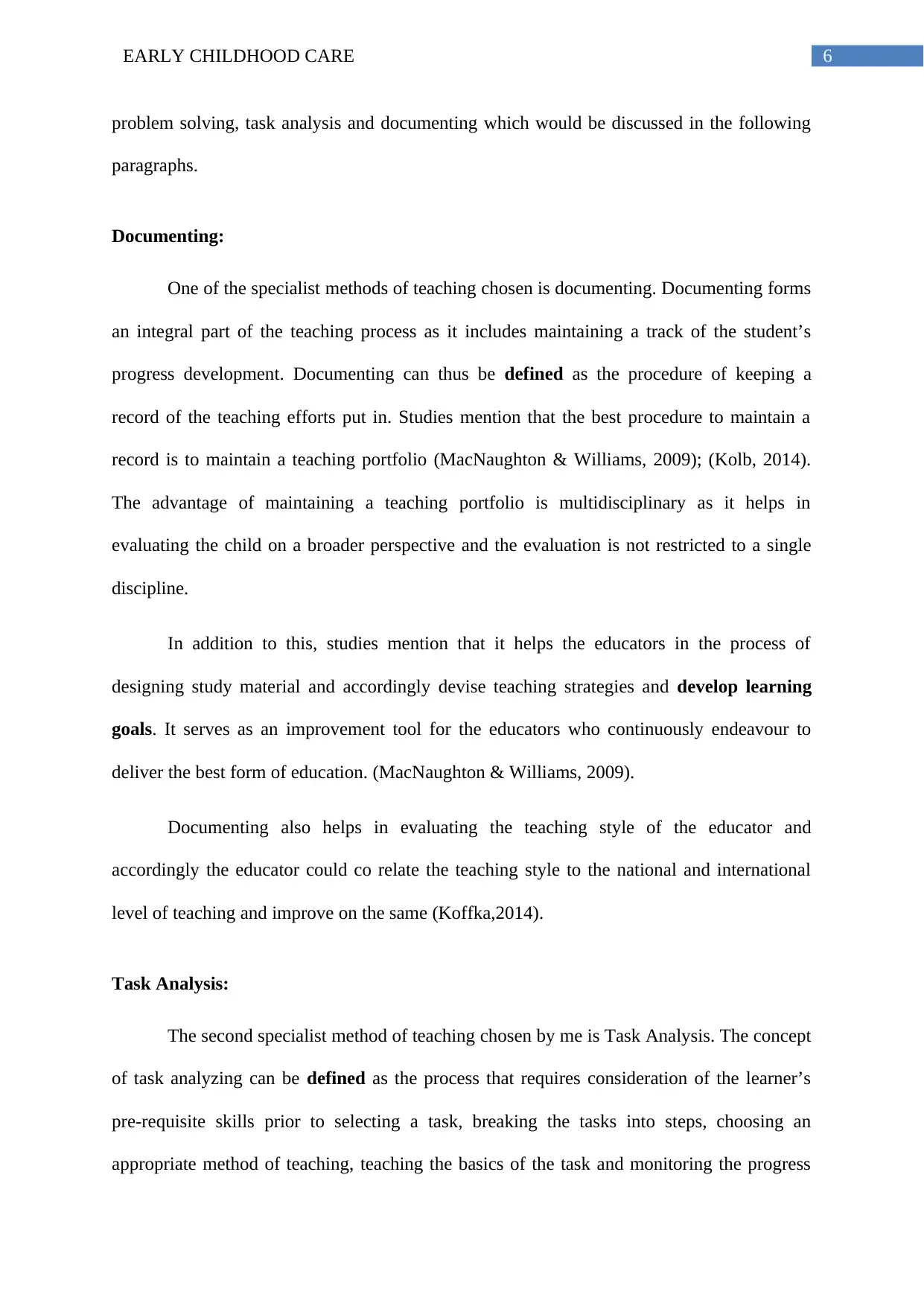
6EARLY CHILDHOOD CARE
problem solving, task analysis and documenting which would be discussed in the following
paragraphs.
Documenting:
One of the specialist methods of teaching chosen is documenting. Documenting forms
an integral part of the teaching process as it includes maintaining a track of the student’s
progress development. Documenting can thus be defined as the procedure of keeping a
record of the teaching efforts put in. Studies mention that the best procedure to maintain a
record is to maintain a teaching portfolio (MacNaughton & Williams, 2009); (Kolb, 2014).
The advantage of maintaining a teaching portfolio is multidisciplinary as it helps in
evaluating the child on a broader perspective and the evaluation is not restricted to a single
discipline.
In addition to this, studies mention that it helps the educators in the process of
designing study material and accordingly devise teaching strategies and develop learning
goals. It serves as an improvement tool for the educators who continuously endeavour to
deliver the best form of education. (MacNaughton & Williams, 2009).
Documenting also helps in evaluating the teaching style of the educator and
accordingly the educator could co relate the teaching style to the national and international
level of teaching and improve on the same (Koffka,2014).
Task Analysis:
The second specialist method of teaching chosen by me is Task Analysis. The concept
of task analyzing can be defined as the process that requires consideration of the learner’s
pre-requisite skills prior to selecting a task, breaking the tasks into steps, choosing an
appropriate method of teaching, teaching the basics of the task and monitoring the progress
problem solving, task analysis and documenting which would be discussed in the following
paragraphs.
Documenting:
One of the specialist methods of teaching chosen is documenting. Documenting forms
an integral part of the teaching process as it includes maintaining a track of the student’s
progress development. Documenting can thus be defined as the procedure of keeping a
record of the teaching efforts put in. Studies mention that the best procedure to maintain a
record is to maintain a teaching portfolio (MacNaughton & Williams, 2009); (Kolb, 2014).
The advantage of maintaining a teaching portfolio is multidisciplinary as it helps in
evaluating the child on a broader perspective and the evaluation is not restricted to a single
discipline.
In addition to this, studies mention that it helps the educators in the process of
designing study material and accordingly devise teaching strategies and develop learning
goals. It serves as an improvement tool for the educators who continuously endeavour to
deliver the best form of education. (MacNaughton & Williams, 2009).
Documenting also helps in evaluating the teaching style of the educator and
accordingly the educator could co relate the teaching style to the national and international
level of teaching and improve on the same (Koffka,2014).
Task Analysis:
The second specialist method of teaching chosen by me is Task Analysis. The concept
of task analyzing can be defined as the process that requires consideration of the learner’s
pre-requisite skills prior to selecting a task, breaking the tasks into steps, choosing an
appropriate method of teaching, teaching the basics of the task and monitoring the progress
Paraphrase This Document
Need a fresh take? Get an instant paraphrase of this document with our AI Paraphraser
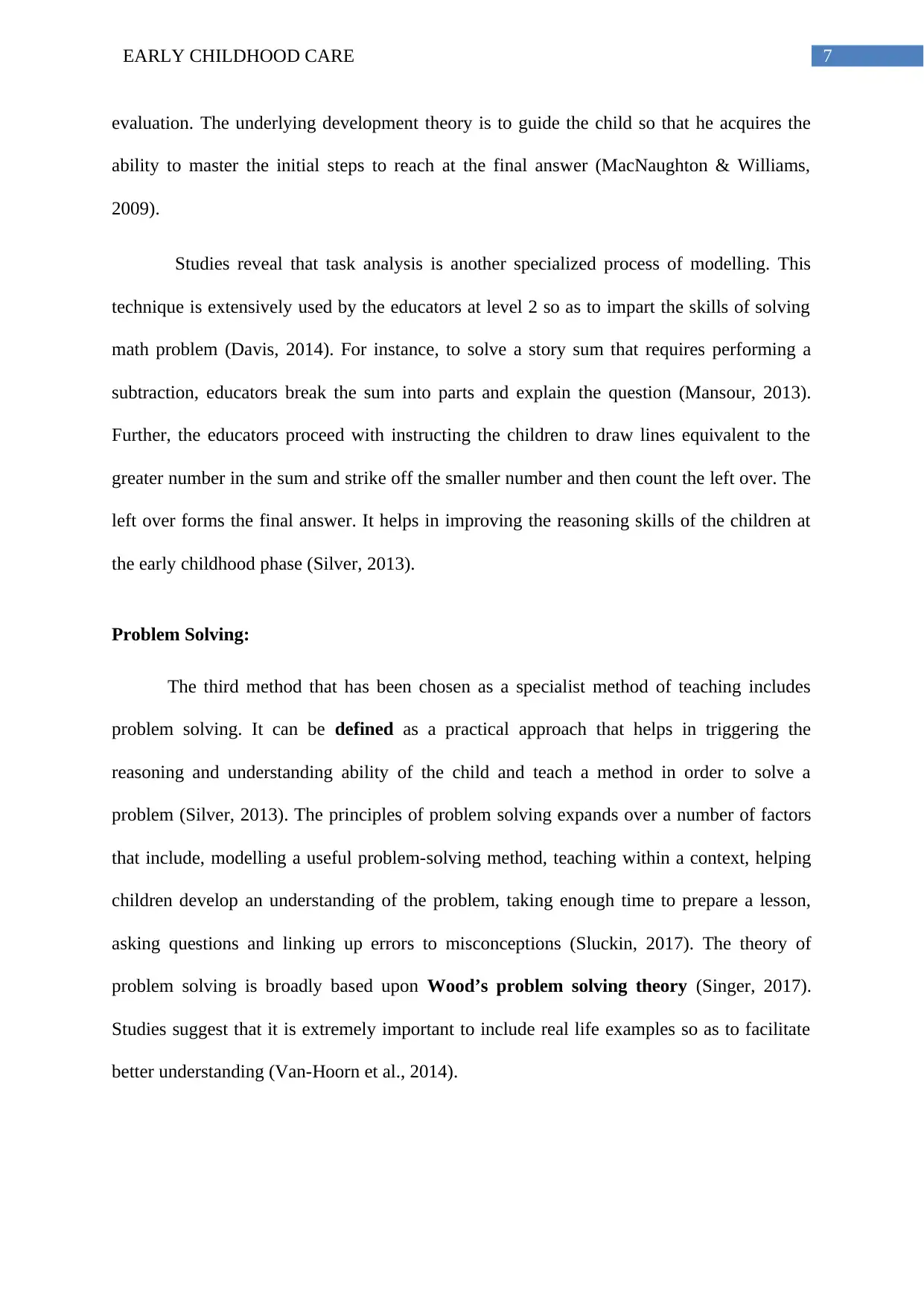
7EARLY CHILDHOOD CARE
evaluation. The underlying development theory is to guide the child so that he acquires the
ability to master the initial steps to reach at the final answer (MacNaughton & Williams,
2009).
Studies reveal that task analysis is another specialized process of modelling. This
technique is extensively used by the educators at level 2 so as to impart the skills of solving
math problem (Davis, 2014). For instance, to solve a story sum that requires performing a
subtraction, educators break the sum into parts and explain the question (Mansour, 2013).
Further, the educators proceed with instructing the children to draw lines equivalent to the
greater number in the sum and strike off the smaller number and then count the left over. The
left over forms the final answer. It helps in improving the reasoning skills of the children at
the early childhood phase (Silver, 2013).
Problem Solving:
The third method that has been chosen as a specialist method of teaching includes
problem solving. It can be defined as a practical approach that helps in triggering the
reasoning and understanding ability of the child and teach a method in order to solve a
problem (Silver, 2013). The principles of problem solving expands over a number of factors
that include, modelling a useful problem-solving method, teaching within a context, helping
children develop an understanding of the problem, taking enough time to prepare a lesson,
asking questions and linking up errors to misconceptions (Sluckin, 2017). The theory of
problem solving is broadly based upon Wood’s problem solving theory (Singer, 2017).
Studies suggest that it is extremely important to include real life examples so as to facilitate
better understanding (Van-Hoorn et al., 2014).
evaluation. The underlying development theory is to guide the child so that he acquires the
ability to master the initial steps to reach at the final answer (MacNaughton & Williams,
2009).
Studies reveal that task analysis is another specialized process of modelling. This
technique is extensively used by the educators at level 2 so as to impart the skills of solving
math problem (Davis, 2014). For instance, to solve a story sum that requires performing a
subtraction, educators break the sum into parts and explain the question (Mansour, 2013).
Further, the educators proceed with instructing the children to draw lines equivalent to the
greater number in the sum and strike off the smaller number and then count the left over. The
left over forms the final answer. It helps in improving the reasoning skills of the children at
the early childhood phase (Silver, 2013).
Problem Solving:
The third method that has been chosen as a specialist method of teaching includes
problem solving. It can be defined as a practical approach that helps in triggering the
reasoning and understanding ability of the child and teach a method in order to solve a
problem (Silver, 2013). The principles of problem solving expands over a number of factors
that include, modelling a useful problem-solving method, teaching within a context, helping
children develop an understanding of the problem, taking enough time to prepare a lesson,
asking questions and linking up errors to misconceptions (Sluckin, 2017). The theory of
problem solving is broadly based upon Wood’s problem solving theory (Singer, 2017).
Studies suggest that it is extremely important to include real life examples so as to facilitate
better understanding (Van-Hoorn et al., 2014).
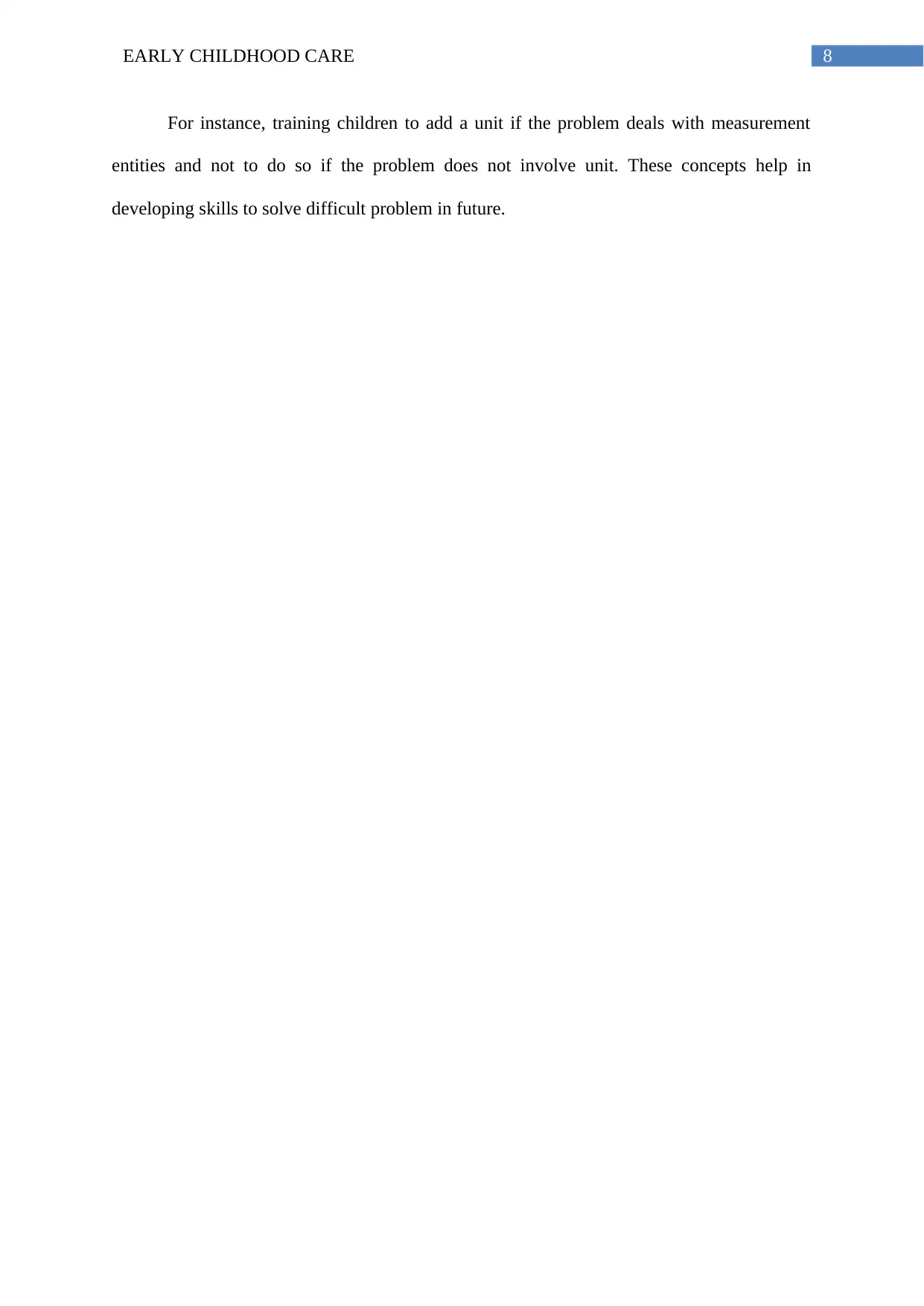
8EARLY CHILDHOOD CARE
For instance, training children to add a unit if the problem deals with measurement
entities and not to do so if the problem does not involve unit. These concepts help in
developing skills to solve difficult problem in future.
For instance, training children to add a unit if the problem deals with measurement
entities and not to do so if the problem does not involve unit. These concepts help in
developing skills to solve difficult problem in future.
⊘ This is a preview!⊘
Do you want full access?
Subscribe today to unlock all pages.

Trusted by 1+ million students worldwide
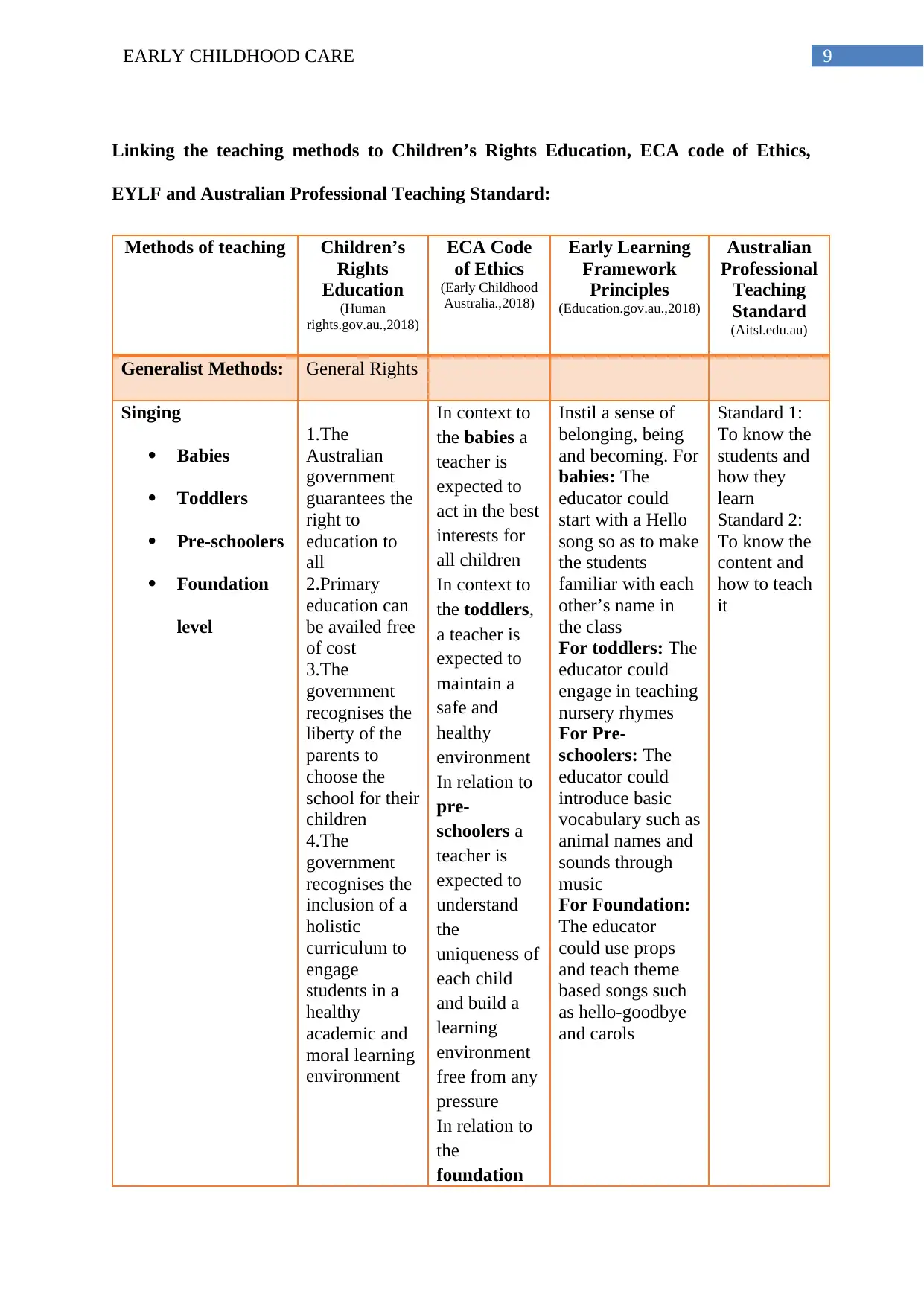
9EARLY CHILDHOOD CARE
Linking the teaching methods to Children’s Rights Education, ECA code of Ethics,
EYLF and Australian Professional Teaching Standard:
Methods of teaching Children’s
Rights
Education
(Human
rights.gov.au.,2018)
ECA Code
of Ethics
(Early Childhood
Australia.,2018)
Early Learning
Framework
Principles
(Education.gov.au.,2018)
Australian
Professional
Teaching
Standard
(Aitsl.edu.au)
Generalist Methods: General Rights
Singing
Babies
Toddlers
Pre-schoolers
Foundation
level
1.The
Australian
government
guarantees the
right to
education to
all
2.Primary
education can
be availed free
of cost
3.The
government
recognises the
liberty of the
parents to
choose the
school for their
children
4.The
government
recognises the
inclusion of a
holistic
curriculum to
engage
students in a
healthy
academic and
moral learning
environment
In context to
the babies a
teacher is
expected to
act in the best
interests for
all children
In context to
the toddlers,
a teacher is
expected to
maintain a
safe and
healthy
environment
In relation to
pre-
schoolers a
teacher is
expected to
understand
the
uniqueness of
each child
and build a
learning
environment
free from any
pressure
In relation to
the
foundation
Instil a sense of
belonging, being
and becoming. For
babies: The
educator could
start with a Hello
song so as to make
the students
familiar with each
other’s name in
the class
For toddlers: The
educator could
engage in teaching
nursery rhymes
For Pre-
schoolers: The
educator could
introduce basic
vocabulary such as
animal names and
sounds through
music
For Foundation:
The educator
could use props
and teach theme
based songs such
as hello-goodbye
and carols
Standard 1:
To know the
students and
how they
learn
Standard 2:
To know the
content and
how to teach
it
Linking the teaching methods to Children’s Rights Education, ECA code of Ethics,
EYLF and Australian Professional Teaching Standard:
Methods of teaching Children’s
Rights
Education
(Human
rights.gov.au.,2018)
ECA Code
of Ethics
(Early Childhood
Australia.,2018)
Early Learning
Framework
Principles
(Education.gov.au.,2018)
Australian
Professional
Teaching
Standard
(Aitsl.edu.au)
Generalist Methods: General Rights
Singing
Babies
Toddlers
Pre-schoolers
Foundation
level
1.The
Australian
government
guarantees the
right to
education to
all
2.Primary
education can
be availed free
of cost
3.The
government
recognises the
liberty of the
parents to
choose the
school for their
children
4.The
government
recognises the
inclusion of a
holistic
curriculum to
engage
students in a
healthy
academic and
moral learning
environment
In context to
the babies a
teacher is
expected to
act in the best
interests for
all children
In context to
the toddlers,
a teacher is
expected to
maintain a
safe and
healthy
environment
In relation to
pre-
schoolers a
teacher is
expected to
understand
the
uniqueness of
each child
and build a
learning
environment
free from any
pressure
In relation to
the
foundation
Instil a sense of
belonging, being
and becoming. For
babies: The
educator could
start with a Hello
song so as to make
the students
familiar with each
other’s name in
the class
For toddlers: The
educator could
engage in teaching
nursery rhymes
For Pre-
schoolers: The
educator could
introduce basic
vocabulary such as
animal names and
sounds through
music
For Foundation:
The educator
could use props
and teach theme
based songs such
as hello-goodbye
and carols
Standard 1:
To know the
students and
how they
learn
Standard 2:
To know the
content and
how to teach
it
Paraphrase This Document
Need a fresh take? Get an instant paraphrase of this document with our AI Paraphraser
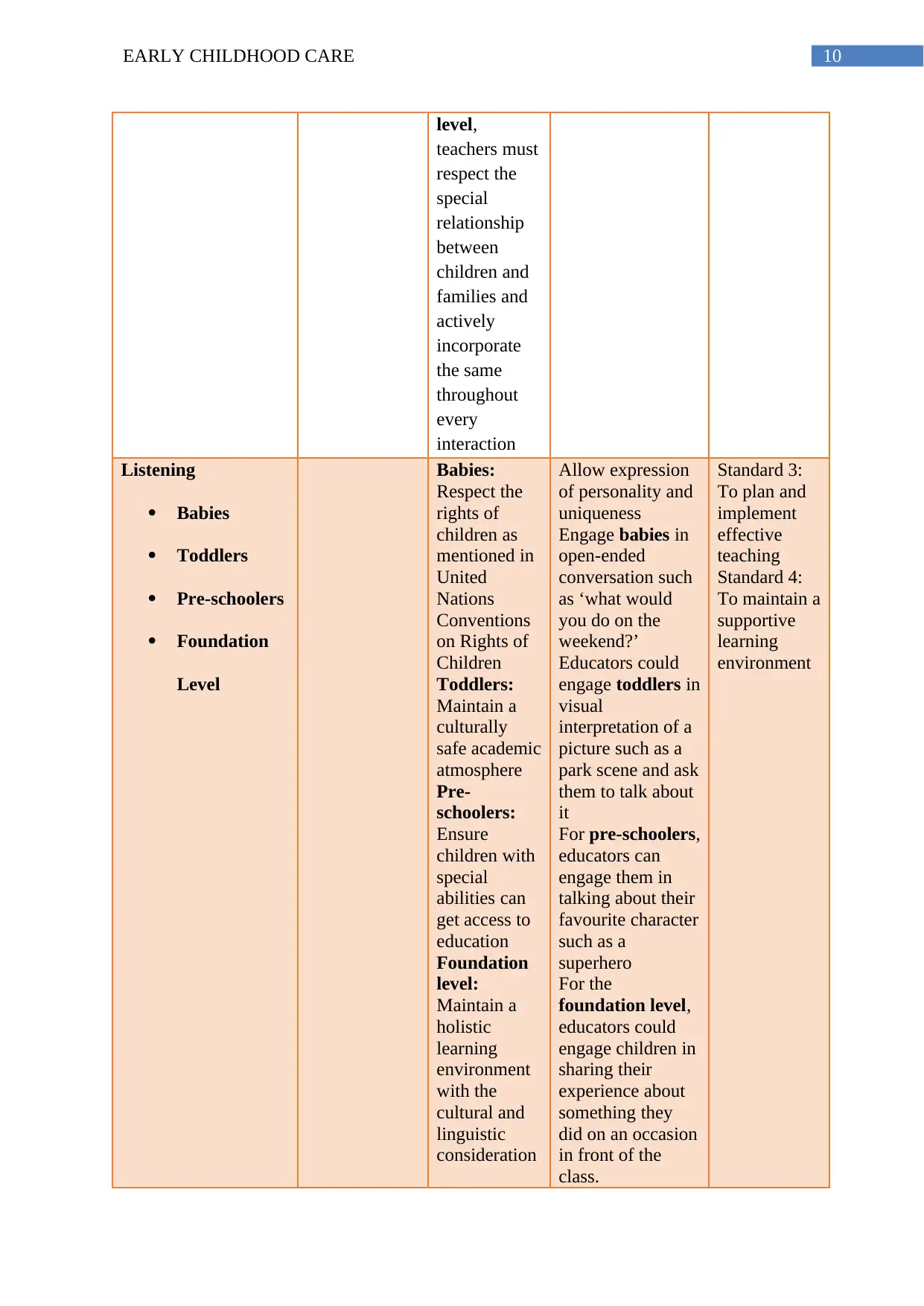
10EARLY CHILDHOOD CARE
level,
teachers must
respect the
special
relationship
between
children and
families and
actively
incorporate
the same
throughout
every
interaction
Listening
Babies
Toddlers
Pre-schoolers
Foundation
Level
Babies:
Respect the
rights of
children as
mentioned in
United
Nations
Conventions
on Rights of
Children
Toddlers:
Maintain a
culturally
safe academic
atmosphere
Pre-
schoolers:
Ensure
children with
special
abilities can
get access to
education
Foundation
level:
Maintain a
holistic
learning
environment
with the
cultural and
linguistic
consideration
Allow expression
of personality and
uniqueness
Engage babies in
open-ended
conversation such
as ‘what would
you do on the
weekend?’
Educators could
engage toddlers in
visual
interpretation of a
picture such as a
park scene and ask
them to talk about
it
For pre-schoolers,
educators can
engage them in
talking about their
favourite character
such as a
superhero
For the
foundation level,
educators could
engage children in
sharing their
experience about
something they
did on an occasion
in front of the
class.
Standard 3:
To plan and
implement
effective
teaching
Standard 4:
To maintain a
supportive
learning
environment
level,
teachers must
respect the
special
relationship
between
children and
families and
actively
incorporate
the same
throughout
every
interaction
Listening
Babies
Toddlers
Pre-schoolers
Foundation
Level
Babies:
Respect the
rights of
children as
mentioned in
United
Nations
Conventions
on Rights of
Children
Toddlers:
Maintain a
culturally
safe academic
atmosphere
Pre-
schoolers:
Ensure
children with
special
abilities can
get access to
education
Foundation
level:
Maintain a
holistic
learning
environment
with the
cultural and
linguistic
consideration
Allow expression
of personality and
uniqueness
Engage babies in
open-ended
conversation such
as ‘what would
you do on the
weekend?’
Educators could
engage toddlers in
visual
interpretation of a
picture such as a
park scene and ask
them to talk about
it
For pre-schoolers,
educators can
engage them in
talking about their
favourite character
such as a
superhero
For the
foundation level,
educators could
engage children in
sharing their
experience about
something they
did on an occasion
in front of the
class.
Standard 3:
To plan and
implement
effective
teaching
Standard 4:
To maintain a
supportive
learning
environment
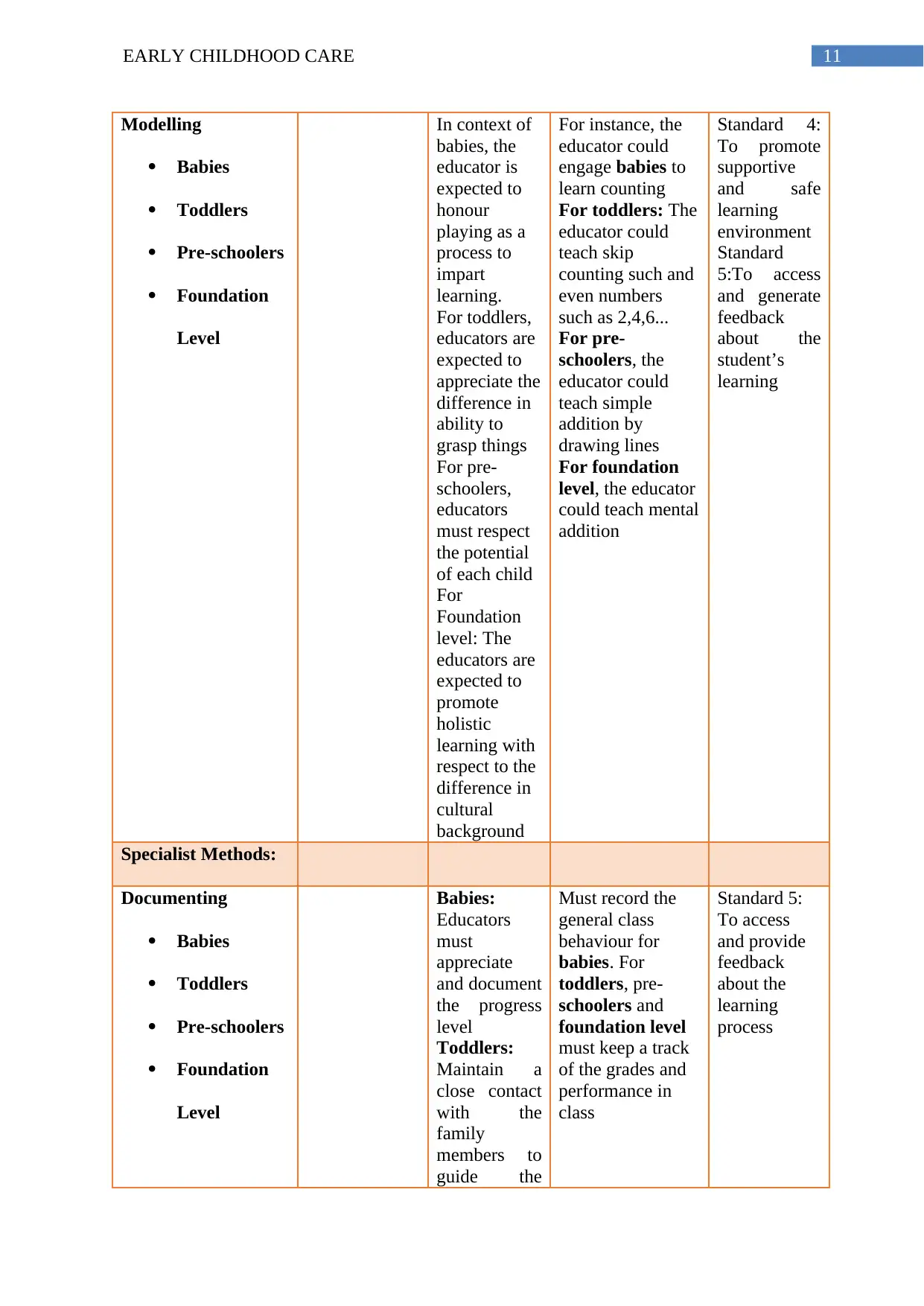
11EARLY CHILDHOOD CARE
Modelling
Babies
Toddlers
Pre-schoolers
Foundation
Level
In context of
babies, the
educator is
expected to
honour
playing as a
process to
impart
learning.
For toddlers,
educators are
expected to
appreciate the
difference in
ability to
grasp things
For pre-
schoolers,
educators
must respect
the potential
of each child
For
Foundation
level: The
educators are
expected to
promote
holistic
learning with
respect to the
difference in
cultural
background
For instance, the
educator could
engage babies to
learn counting
For toddlers: The
educator could
teach skip
counting such and
even numbers
such as 2,4,6...
For pre-
schoolers, the
educator could
teach simple
addition by
drawing lines
For foundation
level, the educator
could teach mental
addition
Standard 4:
To promote
supportive
and safe
learning
environment
Standard
5:To access
and generate
feedback
about the
student’s
learning
Specialist Methods:
Documenting
Babies
Toddlers
Pre-schoolers
Foundation
Level
Babies:
Educators
must
appreciate
and document
the progress
level
Toddlers:
Maintain a
close contact
with the
family
members to
guide the
Must record the
general class
behaviour for
babies. For
toddlers, pre-
schoolers and
foundation level
must keep a track
of the grades and
performance in
class
Standard 5:
To access
and provide
feedback
about the
learning
process
Modelling
Babies
Toddlers
Pre-schoolers
Foundation
Level
In context of
babies, the
educator is
expected to
honour
playing as a
process to
impart
learning.
For toddlers,
educators are
expected to
appreciate the
difference in
ability to
grasp things
For pre-
schoolers,
educators
must respect
the potential
of each child
For
Foundation
level: The
educators are
expected to
promote
holistic
learning with
respect to the
difference in
cultural
background
For instance, the
educator could
engage babies to
learn counting
For toddlers: The
educator could
teach skip
counting such and
even numbers
such as 2,4,6...
For pre-
schoolers, the
educator could
teach simple
addition by
drawing lines
For foundation
level, the educator
could teach mental
addition
Standard 4:
To promote
supportive
and safe
learning
environment
Standard
5:To access
and generate
feedback
about the
student’s
learning
Specialist Methods:
Documenting
Babies
Toddlers
Pre-schoolers
Foundation
Level
Babies:
Educators
must
appreciate
and document
the progress
level
Toddlers:
Maintain a
close contact
with the
family
members to
guide the
Must record the
general class
behaviour for
babies. For
toddlers, pre-
schoolers and
foundation level
must keep a track
of the grades and
performance in
class
Standard 5:
To access
and provide
feedback
about the
learning
process
⊘ This is a preview!⊘
Do you want full access?
Subscribe today to unlock all pages.

Trusted by 1+ million students worldwide
1 out of 18
Related Documents
Your All-in-One AI-Powered Toolkit for Academic Success.
+13062052269
info@desklib.com
Available 24*7 on WhatsApp / Email
![[object Object]](/_next/static/media/star-bottom.7253800d.svg)
Unlock your academic potential
Copyright © 2020–2025 A2Z Services. All Rights Reserved. Developed and managed by ZUCOL.





